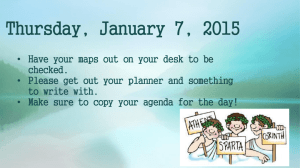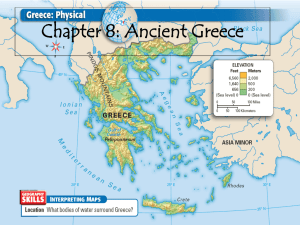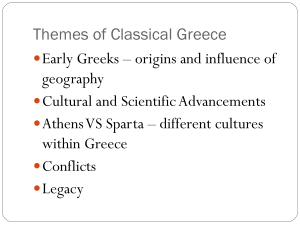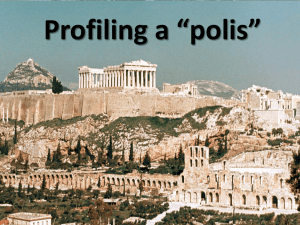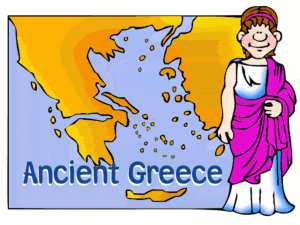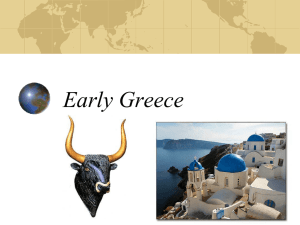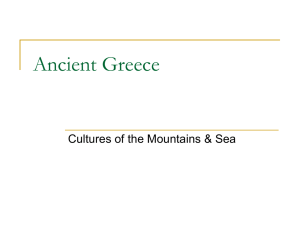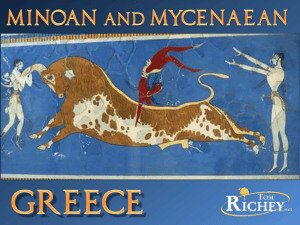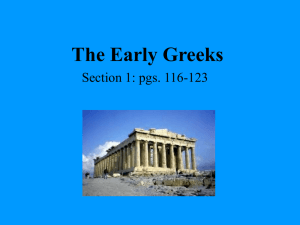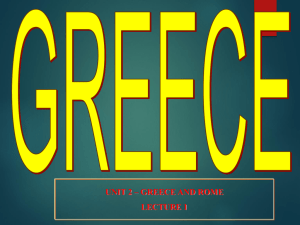File
advertisement
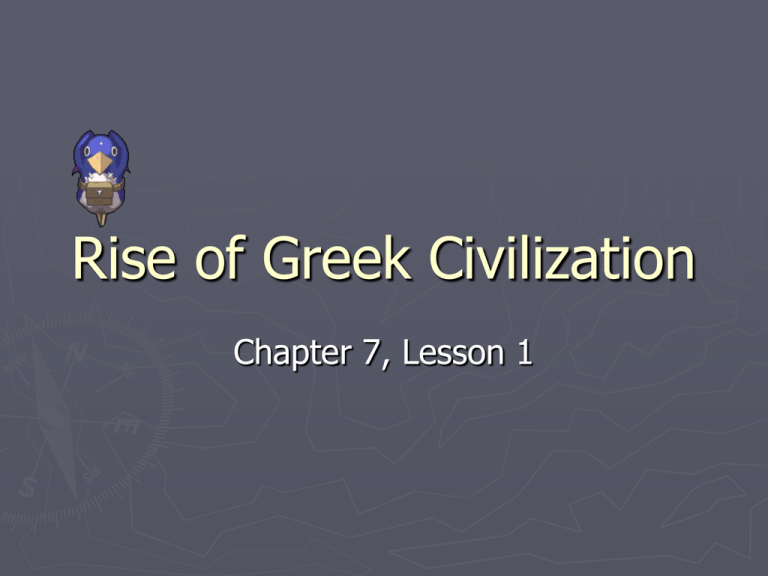
Rise of Greek Civilization Chapter 7, Lesson 1 ► Greece Mountain and Seas was the first civilization to develop in Europe and the westernmost part of Asia. ► In other early civilizations people settled in river valleys that had rich soil. Greek civilization began in an area dominated by mountains and seas. ► Flying over Greece today would treat you to a view of rugged landscapes and beautiful seas. ► Greece is located mainly on the Balkan Peninsula. A peninsula is a body of land with water on three sides. ► Far to the east of the mainland is another peninsula known as Anatolia and is part of present-day Turkey. ► Between Mountains and Seas these two areas is the Aegean Sea. It is actually a part of the much larger Mediterranean Sea. Hundreds of islands are located within it and appear to be small stepping stones between the Greek mainland and Anatolia. ► Greeks traded goods and ideas along their coastline and islands. Today, Fishing and trading are still huge. ► Other Greek areas settled into farming communities. Narrow fertile plains ran along the coast and between the mountains. ► In Mountains and Seas the areas mild climate, farmers grow wheat, barley, olives, and grapes. ► They would also raise sheep and goat. ► Though some communities were by the coast, many were far from the sea. They were separated from each other by rugged mountains and deep valleys. This resulted in many areas becoming independent and in some cases thought of themselves as small separate countries. ► Greek An Island Civilization myth tells of an early civilization on the island of Crete (KREET). Located to the southeast of the mainland. ► Around A.D. 1900, a British Archaeologist named Arthur Evans discovered an area called Knossos (NAH-suhs). Unearthed the palace of a legendary king known as Minos (MY-nuhs). He concluded that Minos and his family lived in the palace with numerous rooms connected by twisting passageways. Some rooms may have been used to store oil, wine, and grain. ► Other An Island Civilization rooms were used as workshops used to make jewelry, vases, and statues. ► The palace even seemed to have bathrooms. ► It is believed this palace was built by the Minoans (muh-NOH-uhnz). They were the first to develop in the area but were not Greek. They lasted from about 2500 B.C. to 1450 B.C. ► Trade was important to the Minoans. Were able to build ships from the oak and cedar trees. They sailed to Egypt and Syria to trade pottery and stone vases for ivory and metals. An Island Civilization ► Minoan ships also sailed the eastern Mediterranean Sea to protect Minoan trade from pirates. ► Some time around 1450 B.C. the Minoan civilization collapsed. Historians do not know why this happened but theorize an underwater earthquake causing waves that destroyed the cities. Other historians believe that they were invaded by the Mycenaean (my-suh-NEE-uhns). A Mainland Civilization ► Around 2000 B.C., the Mycenaean left their homeland in central Asia and moved into mainland Greece. They mixed with the local people and had even set up several kingdoms Mycenaean Kingdom ► Little was known about the Mycenaeans until the late 1800s. A German archaeologist named Heinrich Schliemann (HYN-ryhk SHLEE-mahn) discovered the ruins of a palace in Mycenae. This resulted in him calling them the Mycenaeans. ► Each Mycenaean king lived in a palace constructed atop a hill. Thick stone walls were used to protect the king and his people. ► Nobles Mycenaean Kingdom lived outside the walls on lands called estates. The workers and enslaved people lived on that estate. ► Mycenaean palaces were used as centers of government. ► Artisans there made leather goods, clothes, and jars for storing wine and olive oil. Other workers made swords and ox-hide shields. ► Government officials kept tabs on how rich the kingdom’s residents were. Collected wheat, livesstock, and honey as taxes. Traders and Warriors The Minoan traders from Crete would visit the Greek mainland. ► The Mycenaeans eventually took features of Minoan culture. Building ships and working with bronze. Navigated using the sun and stars. The Mycenaeans also worshipped the Earth Mother, the Minoans chief god. ► By the mid 1400s B.C, the Mycenaeans conquered the Minoans and controlled the Aegean area. Brought new wealth to the Mycenaeans and was used to expand their military strength. They were proud of their military successes in the Trojan War. ► ► Mycenaean A Dark Age Kingdoms would fight one another and earthquakes destroyed their palace fortresses, By 1100 B.C., their civilization crumbled. ► Around this time, groups of warring people were moving throughout the Mediterranean region. One of the groups were the Greek-speaking people known as the Dorians (DOHR-ee-uhns) who invaded most of the Greek mainland from the north and took control of most of it. ► Historians A Dark Age call the next 300 years of Greek History a Dark Age. Trade slowed down. People made fewer things to sell. Most people were poor. Farmers grew only enough food for their families. Writing and record keeping decreased dramatically. ►A A Dark Age few positive things did occur though. Dorian Warriors introduced iron weapons and iron making. Iron tools and weapons were much stronger and cheaper to make than bronze ones. ► As the Dorians pushed into Greece, thousands of Greeks fled from the mainland and settled on the Aegean Islands and the western shore of Anatolia. ► By The Hellenes 750 B.C. many descendants of those who ran away returned. Brought back new ideas, crafts, and skills. Developed small independent communities under local leaders who eventually became kings. ► These people called themselves Hellenes, or Greeks. ► Farmers in these communities grew more food than their family could use. They would then trade their surplus with neighboring people such as the Egyptians or Phoenicians. ► As The Hellenes trade increased, a new need for writing developed. ► They would adopt the alphabet of the Phoenicians who would sailed from the Mediterranean coast. This alphabet consisted on 24 letters representing different sounds. Greatly simplified reading and writing in the Greek language. Record keeping in turn, became easier. People even started writing down stories that had been told by bards, or storytellers orally. ► As Colonies and Trade Greece left the Dark Ages, its population increased. By 700 B.C., local farmers could not produce enough to feed the growing population. ► They began to send people outside the Aegean area to create colonies. A settlement in a new territory that has close ties to its homeland. Many colonies were established along the coast of the Mediterranean Sea and Black Sea between 750 B.C. and 550 B.C. Greek culture would spread into Italy, Sicily, France, Spain, North Africa, and western Asia. Colonies and Trade ► ► ► The colonies traded with their “parent” cities in the Greek mainland. They shipped grains, metals, fish, timber and enslaved people to Greece. In return, Greece sent wine, olive oil, and pottery to the colonies. The Greeks soon began to make coins out of metal. People now traded money for goods rather than bartered for goods. It helped increase the colonies wealth. As demand grew colonies made more goods to meet that demand. Certain colonies specialized in making certain goods. Colonies that raised sheep began to make clothes from their wool. ► Most The Greek City-State of the communities were separated by mountain and seas. Created loyalty to the community they lived in. Communities became independent. ► Nobles who had owned large estates eventually overthrew Greek kings by the end of the Dark Ages. Across Greece nobles ruled numerous city-states. ► Just like in Mesopotamia, city-states were made up of a town or city and it’s surrounding areas. Each city-state or polis acted like its own independent country. English words such as police and politics have their roots in polis. What did a Polis Look Like? ► The polis was the basic political unit of Greek Civilization. ► In the center a fort was built on a hilltop known as an acropolis. Local people would take shelter during an attack here. Also had temples used to worship local gods on the acropolis. ► Outside the acropolis was an open area called an agora. It was usually a market place, but also used as a place to gather and discuss issues, choose officials, pass laws, and carry out business. What did a Polis Look Like? ► City neighborhoods surrounded the agora, Beyond the city were villages and farmland that were apart of the polis. ► The general size of a city-state was usually small since it was surrounded by seas and mountains. Some were only a few square miles in areas. Other covered several hundred square miles in an area. ► By 500 B.C., nearly 300,000 people lived in the city-state of Athens. But most city-states were smaller than this. What Did Citizenship Mean to the Greeks? ► We owe many ideas of citizenship to the Greeks. ► Greek citizens were members of a political community with rights and responsibilities. Male citizens had the right to vote, hold public office, own property, and defend themselves in court. In return, they had the responsibility to serve in government and to fight for their polis as citizen soldiers. What Did Citizenship Mean to the Greeks? Ancient Greek citizenship was different from places like Egypt or Mesopotamia. In Egypt and Mesopotamia you were just subjects. No rights, no voice in government, and no choice but to obey their rulers. ► In Greece city-states only free men who owned property and were born in the polis could be citizens. Believed that the responsibility to run the city-state was their since it was made up of their property. Later the requirement of holding land was removed. Women and children might qualify for citizenship, but had none of the rights that went with it. ► ► In Citizen Soldiers Greece, wars were fought by wealthy nobles riding horses and driving chariots. ► By 700 B.C., citizens called hoplites (HAHPlyts) made up the armies of a city-state. Often fought on foot with heavy round shields, a short sword, and a spear. ► They fought by marching forward shoulder to shoulder in rows. They raised their shields above them to protect from enemy arrows, and the formation was known as a phalanx (FAY-langks). Citizen Soldiers They were proud to fight as brave warriors. They took an oath to saying they would not disgrace themselves, abandon their posts, follow all current and future laws, oppose any who does not follow the law, and follow the religion of their fathers. ► The polis gave many Greeks a sense of belonging. Similar to how people feel about their home states today. ► Citizens place the needs of the polis above themselves. However, this caused a division amongst Greek city-states, and were not unified as a country, weakening them and making it easier to conquer. ►
